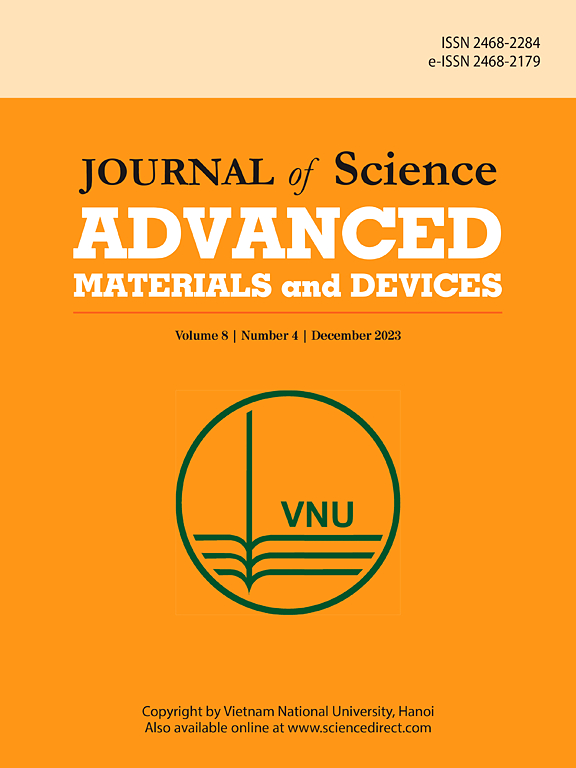Advanced Braille recognition based on protein biomimetic skin mechanical sensors
IF 6.7
3区 材料科学
Q1 MATERIALS SCIENCE, MULTIDISCIPLINARY
Journal of Science: Advanced Materials and Devices
Pub Date : 2025-02-24
DOI:10.1016/j.jsamd.2025.100869
引用次数: 0
Abstract
Tactile perception, dominated by human skin, plays an important role in human-nature interaction, especially when visual perception is limited. The key to mimicking skin tactile perception is to address skin-like properties of materials and integration of biomimetic tactile functions. To be competent in bionic skin, composite silk fibroin (SF) films possessing high tensile properties (159.71 %) and hydrogels with elasticity (54.42 %) were prepared through a mesoscopic reconstruction strategy of SF materials, using fish scale gelatin molecules as mesoscopic templates to regulate the nucleation and crystallization kinetics of SF molecules. In addition, inspired by the mechanoreceptors, a bimodal protein bionic skin (BPBS) was prepared by horizontally integrating a single-electrode triboelectric sensor and a capacitive sensing array, which can work in sliding and pressing modes to mimic the sliding touch and pressing touch of the finger, respectively. The system achieves a 99 % Braille recognition accuracy in sliding mode through a deep learning algorithm, and Bluetooth technology enables real-time wireless Braille recognition in pressing mode, synergistically enhancing the robustness and practicality of BPBS. This research provides novel insights into enhancing human touch perception, human-computer interaction, and the advancement of intelligent prosthetics, marking a significant stride in the development of bionic skins with multimodal sensing capabilities.
基于蛋白质仿生皮肤机械传感器的高级盲文识别
触觉感知在人与自然的互动中起着重要的作用,尤其是在视觉感知有限的情况下。仿生皮肤触觉感知的关键是解决材料的类皮肤特性和仿生触觉功能的集成。为了适应仿生皮肤,通过丝素材料的介观重构策略,以鱼鳞明胶分子为介观模板,调控丝素分子的成核和结晶动力学,制备了具有高拉伸性能(159.71%)的复合丝素膜和具有弹性(54.42%)的复合水凝胶。此外,受机械感受器的启发,通过水平集成单电极摩擦电传感器和电容传感阵列,制备了双峰蛋白质仿生皮肤(BPBS),该皮肤可以在滑动和按压模式下工作,分别模拟手指的滑动和按压触摸。该系统通过深度学习算法在滑动模式下实现了99%的盲文识别准确率,蓝牙技术在按压模式下实现了实时无线盲文识别,协同增强了BPBS的鲁棒性和实用性。本研究为增强人体触觉感知、人机交互和智能假肢的发展提供了新的见解,标志着具有多模态传感能力的仿生皮肤的发展迈出了重要的一步。
本文章由计算机程序翻译,如有差异,请以英文原文为准。
求助全文
约1分钟内获得全文
求助全文
来源期刊

Journal of Science: Advanced Materials and Devices
Materials Science-Electronic, Optical and Magnetic Materials
CiteScore
11.90
自引率
2.50%
发文量
88
审稿时长
47 days
期刊介绍:
In 1985, the Journal of Science was founded as a platform for publishing national and international research papers across various disciplines, including natural sciences, technology, social sciences, and humanities. Over the years, the journal has experienced remarkable growth in terms of quality, size, and scope. Today, it encompasses a diverse range of publications dedicated to academic research.
Considering the rapid expansion of materials science, we are pleased to introduce the Journal of Science: Advanced Materials and Devices. This new addition to our journal series offers researchers an exciting opportunity to publish their work on all aspects of materials science and technology within the esteemed Journal of Science.
With this development, we aim to revolutionize the way research in materials science is expressed and organized, further strengthening our commitment to promoting outstanding research across various scientific and technological fields.
 求助内容:
求助内容: 应助结果提醒方式:
应助结果提醒方式:


